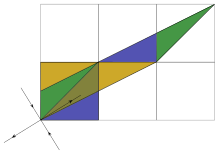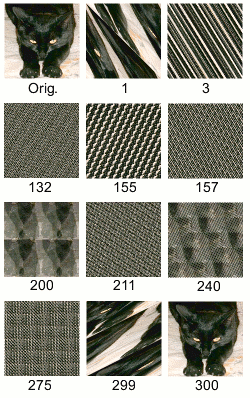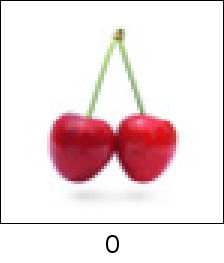|
Arnold's cat map In mathematics, Arnold's cat map is a chaotic map from the torus into itself, named after Vladimir Arnold, who demonstrated its effects in the 1960s using an image of a cat, hence the name.[1] It is a simple and pedagogical example for hyperbolic toral automorphisms. Thinking of the torus as the quotient space , Arnold's cat map is the transformation given by the formula Equivalently, in matrix notation, this is That is, with a unit equal to the width of the square image, the image is sheared one unit up, then two units to the right, and all that lies outside that unit square is shifted back by the unit until it is within the square. NameThe map receives its name from Arnold's 1967 manuscript with André Avez, Problèmes ergodiques de la mécanique classique,[1] in which the outline of a cat was used to illustrate the action of the map on the torus. In the original book it was captioned by a humorous footnote,
In Arnold's native Russian, the map is known as "okroshka (cold soup) from a cat" (Russian: окрошка из кошки), in reference to the map's mixing properties, and which forms a play on words. Arnold later wrote that he found the name "Arnold's Cat" by which the map is known in English and other languages to be "strange".[2] Properties
The discrete cat map  It is possible to define a discrete analogue of the cat map. One of this map's features is that image being apparently randomized by the transformation but returning to its original state after a number of steps. As can be seen in the adjacent picture, the original image of the cat is sheared and then wrapped around in the first iteration of the transformation. After some iterations, the resulting image appears rather random or disordered, yet after further iterations the image appears to have further order—ghost-like images of the cat, multiple smaller copies arranged in a repeating structure and even upside-down copies of the original image—and ultimately returns to the original image. The discrete cat map describes the phase space flow corresponding to the discrete dynamics of a bead hopping from site qt (0 ≤ qt < N) to site qt+1 on a circular ring with circumference N, according to the second order equation: Defining the momentum variable pt = qt − qt−1, the above second order dynamics can be re-written as a mapping of the square 0 ≤ q, p < N (the phase space of the discrete dynamical system) onto itself: This Arnold cat mapping shows mixing behavior typical for chaotic systems. However, since the transformation has a determinant equal to unity, it is area-preserving and therefore invertible the inverse transformation being: For real variables q and p, it is common to set N = 1. In that case a mapping of the unit square with periodic boundary conditions onto itself results. When N is set to an integer value, the position and momentum variables can be restricted to integers and the mapping becomes a mapping of a toroidial square grid of points onto itself. Such an integer cat map is commonly used to demonstrate mixing behavior with Poincaré recurrence utilising digital images. The number of iterations needed to restore the image can be shown never to exceed 3N.[5] For an image, the relationship between iterations could be expressed as follows: ModelsPython code for Arnold's Cat Mapimport os
from PIL.Image import open as load_pic, new as new_pic
def main(path, iterations, keep_all=False, name="arnold_cat-{name}-{index}.png"):
"""
Params
path:str
path to photograph
iterations:int
number of iterations to compute
name:str
formattable string to use as template for file names
"""
title = os.path.splitext(os.path.split(path)[1])[0]
counter = 0
while counter < iterations:
with load_pic(path) as image:
dim = width, height = image.size
with new_pic(image.mode, dim) as canvas:
for x in range(width):
for y in range(height):
nx = (2 * x + y) % width
ny = (x + y) % height
canvas.putpixel((nx, height-ny-1), image.getpixel((x, height-y-1)))
if counter > 0 and not keep_all:
os.remove(path)
counter += 1
print(counter, end="\r")
path = name.format(name=title, index=counter)
canvas.save(path)
return canvas
if __name__ == "__main__":
path = input("Enter the path to an image:\n\t")
while not os.path.exists(path):
path = input("Couldn't find your chosen image, please try again:\n\t")
result = main(path, 3)
result.show()
See alsoReferences
External links |
Portal di Ensiklopedia Dunia
















